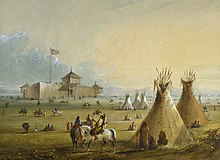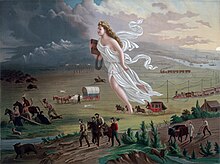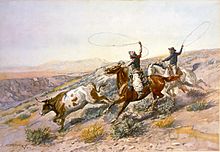American Old West
Appearance
The American Old West (often referred to as the Old West, Wild West or Far West) comprises the history, geography, people, lore, and cultural expression of life in the Western United States, most often referring to the period of the later half of the 19th century, between the American Civil War and the end of the century.
| This theme article is a stub. You can help out with Wikiquote by expanding it! |
Sourced
[edit]






- The Western is ultimately a stripped down moral universe that is, whatever the dramatic problems are, beyond the normal avenues of social control and social alleviation of the problem, and I like to do that even within contemporary stories.
- David Giller as quoted in Axmaker, Sean (October 3, 2005). "Walter Hill: "Operate on your instinct". GreenCine Daily. Retrieved December 12, 2007.
- We didn't build this Nation by everyone scratching and clawing for himself. We built it, like we built the West, by pitching in together and by always acting responsibly.
- Lyndon B. Johnson, Remarks at the State Building in Reno. October 12, 1964.
- You and your forebears… tamed a wild frontier. And, believe it or not, you did it without an area redevelopment program or urban renewal. So now, load up the musket and help us conquer this wild growth and centralization of power which threatens all that we've created.
- Ronald Reagan, Remarks at a Rally for Senator Malcolm Wallop in Cheyenne, Wyoming. March 2, 1982.
- I examine sociological models of how people use and interpret cultural materials. My focus is on how minorities participate in and rework the central myths of the dominant culture. After viewing a Western film, matched groups of American Indian and Anglo males answered written questionnaires and participated in focus-group interviews. American Indians and Anglos both liked the film, but for different reasons. Indians perceived Westerns as representing a set of values about the land, autonomy, and freedom, while Anglos linked the Western myth to their own history and turned it into an affirmation of the values their ancestors strove for and imposed on the West. These results imply that the meaning imputed to cultural works varied over social space.
- JoEllen Shively, “Cowboys and Indians: Perceptions of Western Films Among American Indians and Anglos”, American Sociological Review, Vol. 57, No. 6 (Dec., 1992), pp. 725
- Cawelti (1970, 1976), on the basis of his reading of Western novels, concluded that these novels are a vehicle for exploring value conflicts, such as communal ideas versus individualistic impulses, and traditional ways of life versus progress. Cawelti argued that Westerns are formulaic works that provide readers with a vehicle for escape and moral fantasy.
In the major sociological study of Western films, Wright (1977) used his own viewing of the most popular Western movies from 1931 to 1972 to argue that Westerns resemble primitive myths. Drawing on Levi-Strauss, Wright developed a cognitive theory of mythic structures in which “the receivers of the Western myth learn how to act by recognizing their own situation in it” (p. 186). Wright’s main thesis is that the narrative themes of the Western resolve crucial contradictions in modern capitalism and provide viewers with strategies to deal with their economic worlds. The popularity of Westerns, Wright argue, lies in the genre’s reflection of the changing economic system, which allows the viewers to use the Western as a guide for living.
These explanations of the Western’s popularity attended to cultural texts but ignore the viewers, whose motives and experiences are crucial. The lack of solid data about audience interpretations of various formulas renders existing models of the cultural significance of Westerns and other genres speculative.- JoEllen Shively, “Cowboys and Indians: Perceptions of Western Films Among American Indians and Anglos”, American Sociological Review, Vol. 57, No. 6 (Dec., 1992), pp. 725
- Go West, young man, and grow up with the country.
- John Soule, Terre Haute Express (1851).
- The existence of an area of free land, its continual recession, and the advancement of American settlement westward, explain American development.
- Frederick Jackson Turner to the American Historical Association at the 1893 World's Columbian Exposition in Chicago, Illinois
- “People were allowed to own guns, and everyone did own guns [in the West], for the most part,” says Winkler. “Having a firearm to protect yourself in the lawless wilderness from wild animals, hostile native tribes, and outlaws was a wise idea. But when you came into town, you had to either check your guns if you were a visitor or keep your guns at home if you were a resident.”
- Adam Winkler as qtd. by Matt Jancer in “Gun Control Is as Old as the Old West”, Smithsonian, (February 5, 2018).
- Frontier towns with and without gun legislation were violent places, more violent than family-friendly farming communities and Eastern cities of the time, but those without restrictions tended to have worse violence. “I've never seen any rhetoric from that time period saying that the only thing that's going to reduce violence is more people with guns,” says Winkler. “It seems to be much more of a 20th-century attitude than one associated with the Wild West.”
- Adam Winkler; as qtd. by Matt Jancer in “Gun Control Is as Old as the Old West”, Smithsonian, (February 5, 2018).

